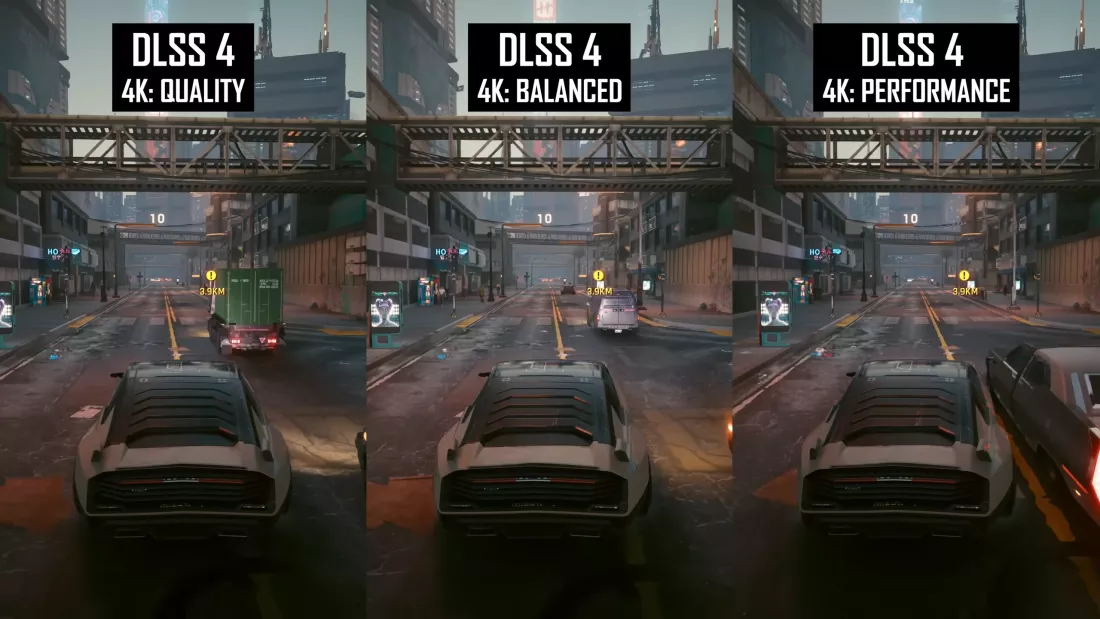When enabling DLSS upscaling, the go-to option for most gamers is simply using the Quality mode – the setting that has traditionally offered the best balance between image clarity and improved frame rates. But with the arrival of DLSS 4, Nvidia has introduced meaningful improvements across all presets, including the often overlooked Balanced and Performance modes.
In this breakdown and video analysis, we take a closer look at how each of the three main DLSS 4 presets performs across a variety of gaming scenarios. Does dropping down from Quality still come at a major visual cost? Or have lower modes quietly become the smarter choice for many setups?

We’ve tested DLSS 4 at 4K, 1440p, and 1080p on a GeForce RTX 5090, locked to 60 frames per second. To ensure consistency, we disabled effects like motion blur and chromatic aberration, and applied the same sharpening settings across every sample. The results might surprise anyone still clinging to Quality mode by default.
Texture Quality
One of the most impressive aspects of DLSS 4 is how it eliminates TAA blur in a lot of situations, preserving full texture quality as we move through the game world. This gives DLSS 4 a sharper overall presentation compared to previous versions and even native rendering.
The good news for gamers is this is largely a universal aspect of the technology that applies across all presets and resolutions. So whether you use 4K Quality or 4K Performance or 1080p Quality or 1080p Performance, the texture quality and blurriness of the image are very similar. With this version of DLSS, you’re not adding blur when turning down the preset to Performance, and this makes those lower settings more viable.
The only main impact to texture quality at lower DLSS modes is slight amounts of graininess that can be introduced in motion, though on the whole, the ability of DLSS to reconstruct textures is impressive. At 4K, there is little to no texture quality loss using Performance or Balanced compared to Quality, while at 1440p and 1080p we only spotted a few differences comparing Performance to Quality.
Balanced is very viable at these lower resolutions in this aspect of image quality, so if overall blur was one of the main reasons you’ve steered clear of lower DLSS modes, DLSS 4 should have you reconsidering that choice.
Image Stability
Stability is another area that really impressed us with DLSS 4, and this applies to most of the available presets. At 4K in particular, there tends to be very little difference in overall stability between the Quality and Performance modes, which makes the lower modes viable in many gaming scenarios.
Occasionally we were able to spot a slight degradation in fine details, pixel level wires and lines, that sort of thing, but even with relatively fast motion like driving a car, the 4K DLSS Performance mode holds up well and you won’t notice much of a downgrade from Quality in this area.
At 1440p and 1080p it was a little different, as some aspects of fine details are degraded at the lower modes, which are rendering the image well below 1080p. Reconstruction of wires in motion isn’t especially amazing at these lower resolutions in general, but there is a small quality loss when dropping from Quality to Balanced to Performance, with more aliasing and sizzling along those edges. In situations where at 4K these modes held up quite well in terms of preserving these elements, at 1440p and 1080p you’d probably want to stick to the higher quality modes.
With that said, the general stability of the image isn’t substantially different between the modes even at 1080p. If there aren’t fine elements in high contrast scenarios on screen, it’s unlikely you’ll notice huge shimmering or sizzling issues with DLSS 4 even on the Performance mode, though the faster the motion is, the more likely you are to spot problems.
This isn’t like FSR 3, where the image starts out with poor stability and degrades further when turning down the upscaling mode.










